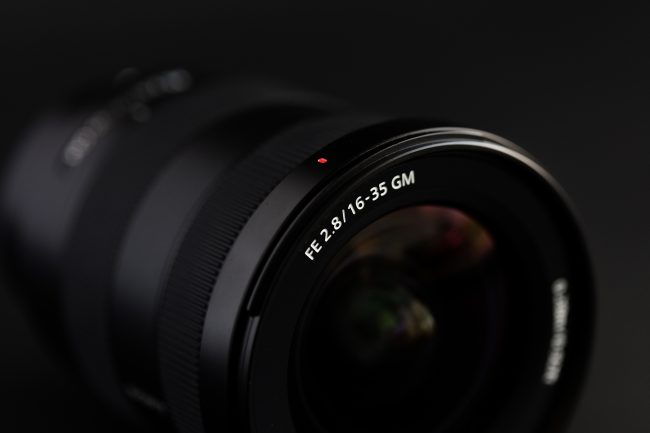Equipment
Sony FE 16-35mm f/2.8 GM Sharpness Tests
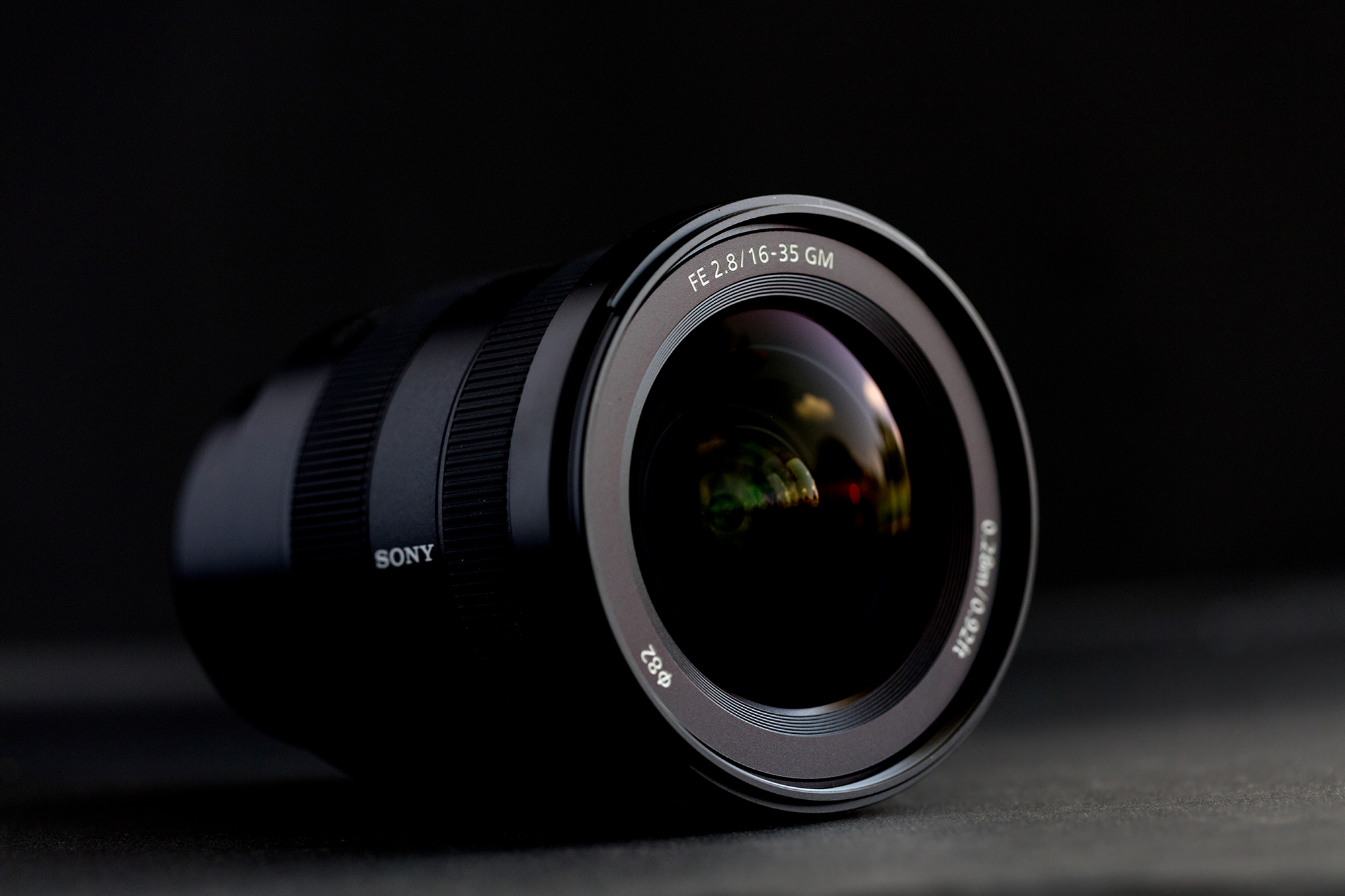
Well, I’ll say to start with I’ve probably had more requests for the Sony FE 16-35mm f/2.8 GM MTF tests than any lens in recent memory. People are excited about it. About half the requests have been very reasonable “I’m hoping to see MTF results before I decide between this lens and that.” And, as has become far too common with Sony lenses lately, about half were fanboyish “I can’t wait to see the new Sony FE 16-35 smoke the Canon 16-35mm f/2.8 Mk III.”
For those who don’t like to read, I’ll save you lots of time. This is a very good lens with interesting characteristics that I think will make it a photographer favorite. It’s expensive, but not massively more than the Canon 16-35mm f/2.8 Mk III. But if you’re a fanboy looking for numbers that ‘destroy’ the competition, you’ll have to go to one of those number-generating sites that say it pulled 72.3 smoke units out of their butt. This post won’t be for you.
MTF Curves
As always, these are the average curves obtained by testing 10 lenses, each at four different rotations from edge-to-edge. So each point on the MTF graph is the average of 80 readings for each frequency.
16mm
The lens is at its best at 16mm, where it’s sharp in the center even at higher frequencies. It maintains sharpness very well through the middle half of the image, then fades a little bit, but not much. There is a little astigmatism-like separation of the sagittal and tangential curves in the outer half, but again far less than we expect in a wide-angle zoom. This is an excellent performance at 16mm as I’ll show you in some later comparisons.
More than just absolute numerical performance, the MTF curves suggest a very smooth, even performance across the entire image frame. That’s something few wide-angle lenses of any type do, much less a wide-angle zoom.
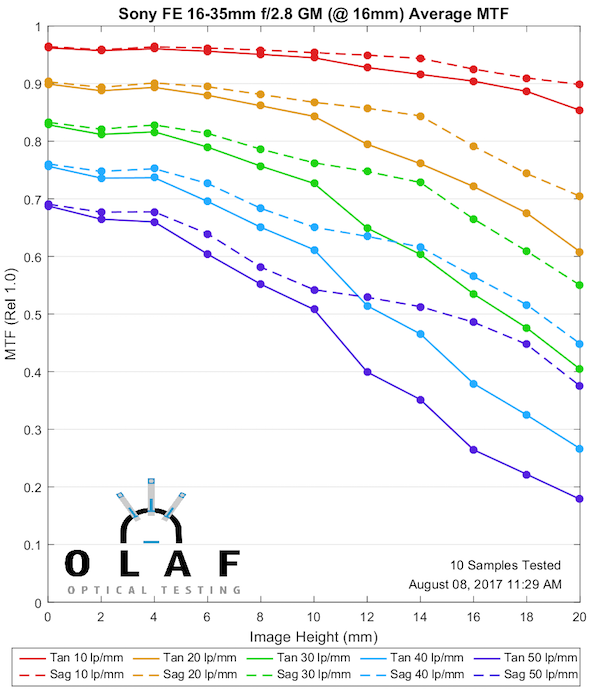
Olaf Optical Testing, 2017
24mm
Like most wide zooms, things aren’t quite as sharp at 24mm, both in the center and out towards the edges. Still, this is a very good performance, and the lens is still going to generate nice, sharp images here.
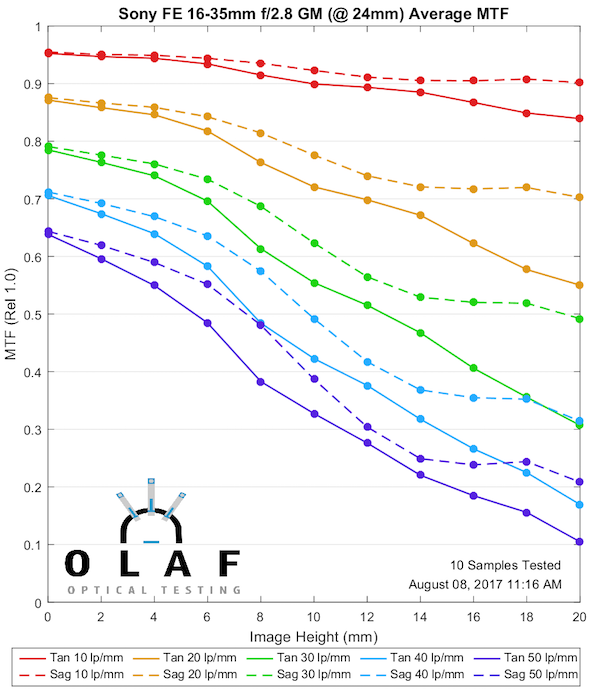
Olaf Optical Testing, 2017
35mm
Following the usual wide zoom pattern, things fall off a bit more at the long end of the zoom range. It’s not bad, by any means, but not nearly as sharp as it was at 16mm. As is the usual case with wide angle zooms, at 35mm you’d probably be better served by changing over to your 24-70mm lens, but this is still very usable.
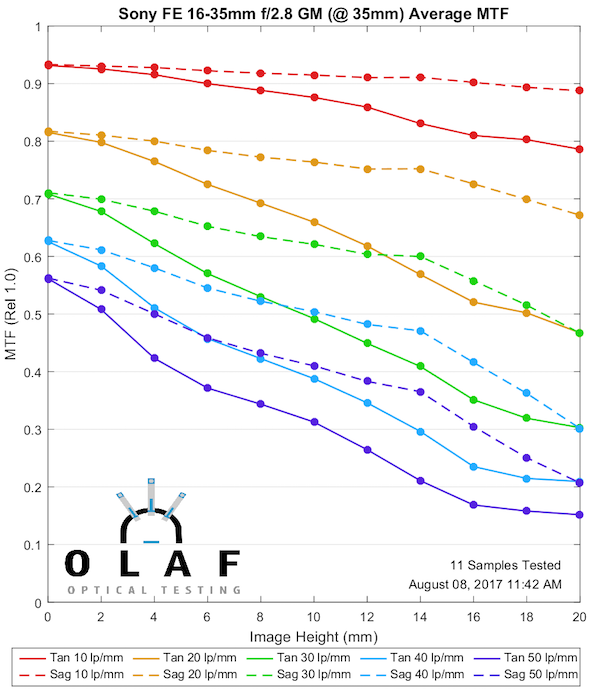
Olaf Optical Testing, 2017
Full-Field MTF Patterns
For those who don’t like MTF, this provides a nice, intuitive look at the relative sharpness of the lens at various focal lengths.
These are done at 30 line pairs/mm and are the average of Sagittal and Tangential numbers, so we’ve lost a lot of data that you can see in the MTF graphs in exchange for a more intuitive overview. Basically dark blue is as sharp as you would like; lighter blue is reasonably sharp, green and yellow is somewhat blurry but can be improved with some aggressive post processing.
16mm
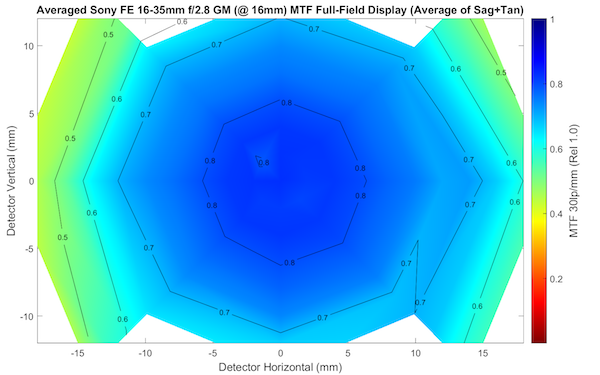
Olaf Optical Testing, 2017
24mm
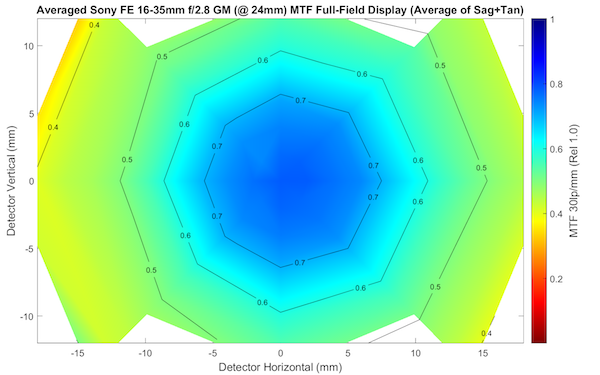
Olaf Optical Testing, 2017
35mm
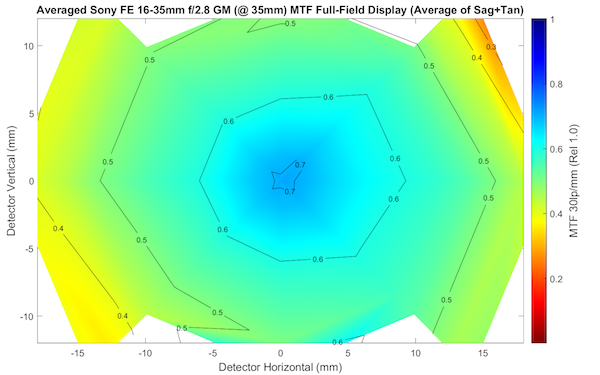
Olaf Optical Testing, 2017
MTF vs Field vs Focus (AKA Field of Focus Curves)
These are possibly the most useful curves we can give you. I need to point out that these are not the average of 10 lenses, rather they are examples of a single lens that was fairly representative. Since it is a single lens, you may see a little field tilt here or there, most zooms have some. (If you’re wondering why we don’t average 10 of these, it’s because they take about 30 minutes each to do and have enough data points that trying to average them would bring our computer to it’s knees.)
16mm
A very slight mustache field at 16mm. This is excellent, though, for a 16mm lens. Notice that the sagittal and tangential curves match up very well, which we expected after seeing the MTF curves above.

Olaf Optical Testing, 2017
24mm
The field flattens somewhat at 24mm. This copy is slightly decentered at this focus distance and has a little tilt in the tangential field. This isn’t severe, by any means, but would be noticeable if you pixel-peep. If you untilt the tangential curve in your mind, you can see that at the edges the tangential field is not lined up with the sagittal field, which we saw in the MTF curve again.

Olaf Optical Testing, 2017
35mm
At 35mm the sagittal field is quite flat. The tangential field is flat in the middle 2/3 of the image but shifts pretty dramatically at the edges. There’s going to be edge astigmatism at the 35mm focal length. This copy is well centered, but slightly tilted. The tilt is slight enough (draw an imaginary line across the graph at “0” on the X axis) that it probably is not noticeable even with pixel peeping. Probably.

Olaf Optical Testing, 2017
Comparisons
Sony FE 16-35mm f/2.8 GM vs Canon 16-35mm f/2.8 L Mk III
The Canon 16-35mm f/2.8L Mk III is arguably the best 16-35mm f/2.8 lens, and therefore we consider it the standard at this focal length.
16mm
The Canon has an amazingly high resolution right in the center, especially at higher frequencies where the difference between it and the Sony is dramatic. But the Sony’s smooth curves give it better resolution in the outer half of the image, and the Sony has less sag-tan separation (this can be caused by either astigmatism or lateral color) so it’s likely to have a smoother look and could have smoother bokeh (lots of other factors contribute to bokeh).
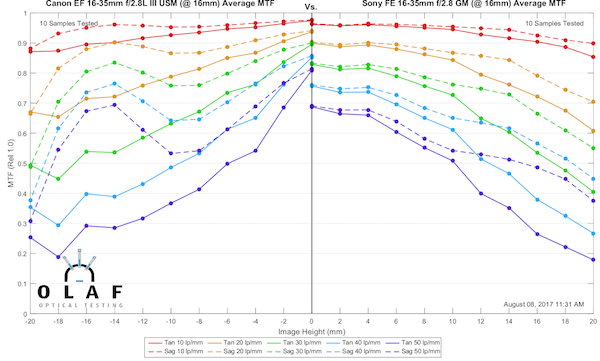
Olaf Optical Testing, 2017
As an aside, I’ll use this as a good example of why single-number ratings are so silly. If you weight the center of the image, the Canon’s going to have a higher rating. If you rate the entire image evenly, they’re going to be pretty equal. If you rate astigmatism as a huge problem, the Sony will have a better rating. My non-numeric rating is they are both excellent, but I expect they’ll have a very different look, and different people will prefer one over the other.
24mm
At 24mm center resolution is pretty equal. Throughout most of the image the Canon maintains slightly better resolution, although it drops off at the edges.
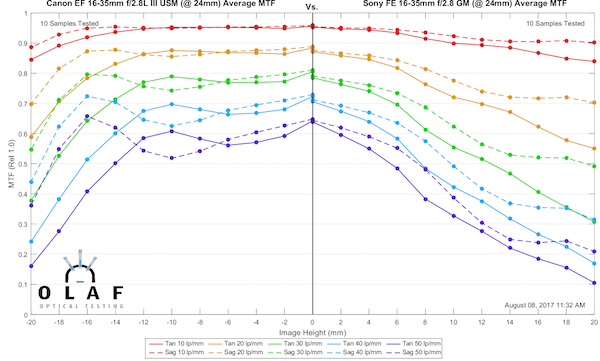
Olaf Optical Testing, 2017
35mm
The 35mm the Canon has a bit better resolution through most of the image, and the sagittal-tangential difference is now clearly better on the Canon. They’re both good though, and this is not a huge difference by any means. As I mentioned earlier, if you’re carrying a 24-70mm f/2.8 lens you’ll find it’s slightly better at 35mm than either of these, but both are still very acceptable.
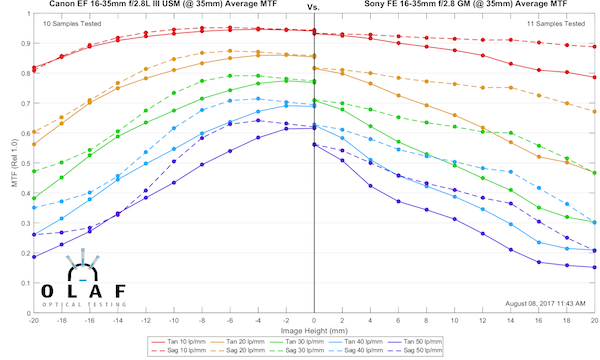
Olaf Optical Testing, 2017
Sony FE 16-35mm f/2.8 GM vs. Sony 16-35mm f/4 ZA OSS
This is a logical comparison that will be a choice for a lot of people. The ZA is a very good lens and significantly less expensive.
Remember the ZA OSS is being tested at f/4, the GM at f/2.8, so we would expect the ZA to have better MTF performance. (Before you ask me to test the GM f/4, the cost of a 10-lens, 3-focal length run is $3,700, so if you’d like it done just send a check with your request.)
16mm
At 16mm, the ZA does have higher resolution in the center 1/3 of the image, although things would probably be even if we had tested the GM lens at f/4. Away from the center, though, even at f/2.8 the GM is clearly better.
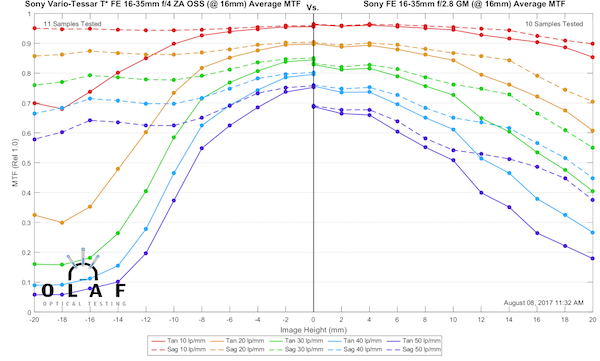
Olaf Optical Testing, 2017
24mm
Things are more even at 24mm. The ZA is better at higher frequencies in the middle half of the image, but there is still far more sagittal-tangential separation on the ZA lens.
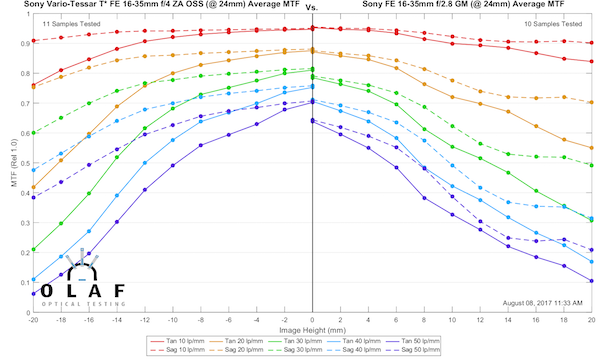
Olaf Optical Testing, 2017
35mm
Things change a little at 35mm, where the ZA actually has less sagittal-tangential separation, but again the GMs performance at f/2.8 is very similar to the ZA’s performance at f/4. The bottom line is if you want to shoot at f/2.8 you don’t have to give up resolution to do so. That’s a very big deal.
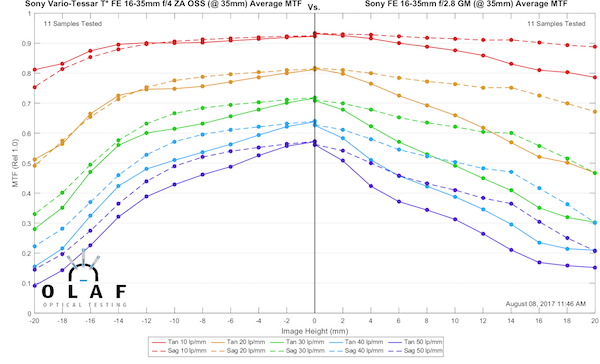
Olaf Optical Testing, 2017
Sony FE 16-35mm f/2.8 GM vs. Sony FE 12-24mm f/4
I put this comparison up because I know some people are interested in it. Obviously, the 12-24m is much better from 12-16mm. I don’t have 16mm data on the 12-24 because we only test 2X zooms at their extremes. But I can compare them at 24mm. There’s not a lot of difference between the GM at f/2.8 and the 12-24mm at f/4.
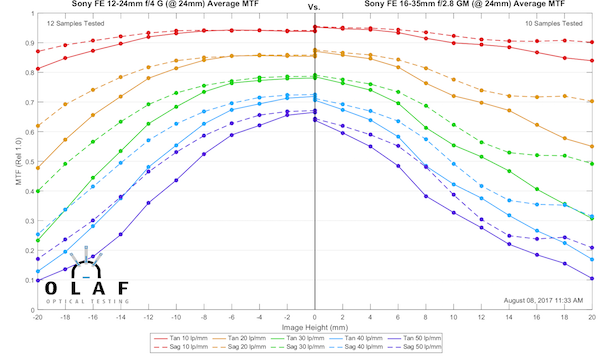
Olaf Optical Testing, 2017
Variation
The FE 16-35 f/2.8 GM repeats a pattern we’ve seen fairly often, but it’s a bit more extreme than usual. At 16mm and 24mm it’s pretty consistent. At 35mm it’s a random crap shoot. How random? At 35mm, copy-to-copy variation is, well, going to cause some issues.
Let me just show you the full field displays for the first 11 lenses I tested at 35mm. These are the ones that went into making the average in the display above.
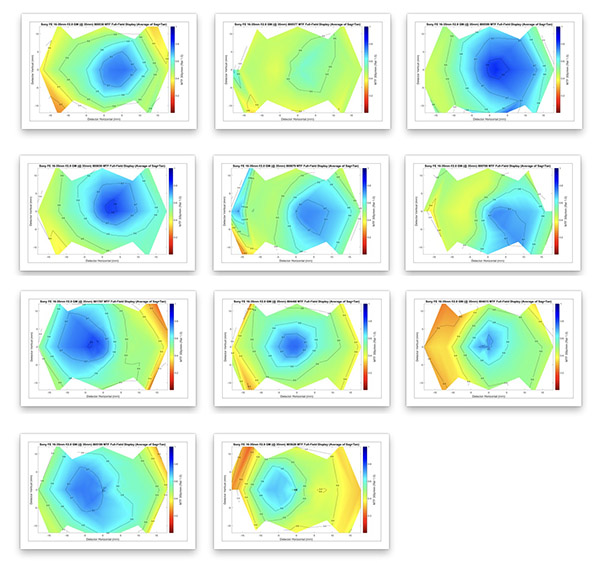
Olaf Optical Testing, 2017
I’m not posting the 16mm and 24mm variations trying to keep this reasonably brief, but at those two focal lengths there wasn’t much variation. We had one copy that was truly bad out of 11 tested at 24mm, but that copy was excellent at 16mm and 35mm. All of the copies we tested were very similar at 16mm.
Conclusion
The Sony 16-35mm f/2.8 GM lens is an excellent optic at 16mm and 24mm. If you want to shoot wide at f/2.8 on an FE mount camera it’s probably the optic of choice. The 16-35 ZA f/4 is a good lens and a lot cheaper if you don’t need f/2.8, but the GM is just better optically. It’s not better or worse than the Canon 16-35mm f/2.8L Mk III, it’s different, and some people will certainly like it’s look better.
But if you plan on using it at 35mm, which I generally don’t recommend for wide zooms if you have alternatives, well, you’re probably going to go through several copies before you find the one you want. Personally, I think it’s a really good 16-24mm f/2.8 zoom that can be used at 35mm if you have to.
Roger Cicala and Aaron Closz
Lensrentals.com
August, 2017
Author: Roger Cicala
I’m Roger and I am the founder of Lensrentals.com. Hailed as one of the optic nerds here, I enjoy shooting collimated light through 30X microscope objectives in my spare time. When I do take real pictures I like using something different: a Medium format, or Pentax K1, or a Sony RX1R.
-
Roger Cicala
-
SpecialMan
-
Chik Sum
-
Roger Cicala
-
Dianoda
-
obican
-
Messier77
-
Roger Cicala
-
Roger Cicala
-
Messier77
-
Athanasius Kirchner
-
Adam Palmer
-
Dianoda
-
Sid
-
Chik Sum
-
Roger Cicala
-
Tianhang
-
VPR
-
Matt
-
Chik Sum
-
6degrees
-
Roger Cicala
-
Roger Cicala
-
DislikeATT
-
User Colin
-
Chik Sum
-
Brandon Dube
-
Roger Cicala
-
ll-ll
-
Joel Cure
